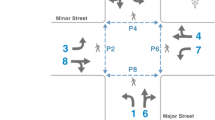Abstract
Automated guided vehicles (AGVs) are an important component for automating container terminals. When utilizing AGVs to transport containers from one position to another in a container terminal, deadlocks are a serious problem that must be solved before real operations can take place. This study assumes that the traveling area for AGVs is divided into a large number of grid-blocks, and, as a method of traffic control, grid-blocks are reserved in advance when AGVs are running. The first purpose of the reservation is to make room between AGVs and to prevent deadlocks. The objective of this study is to develop an efficient deadlock prediction and prevention algorithm for AGV systems in automated container terminals. Because the size of an AGV is much larger than the size of a grid-block on a guide path, this study assumes that an AGV may occupy more than one grid-block at a time. This study proposes a method for reserving grid-blocks in advance to prevent deadlocks. A graphical representation method is suggested for a reservation schedule and a priority table is suggested to maintain priority consistency among grid-blocks. It is shown that the priority consistency guarantees deadlock-free reservation schedules for AGVs to cross the same area at the same time. The proposed method was tested in a simulation study.
















Similar content being viewed by others
References
Aho AV, Hopcroft JE, Ullman JD (1974) The design and analysis of computer algorithms. Addison-Wesley, Reading, pp 189–195
Banaszak ZA, Krogh BH (1990) Deadlock avoidance in flexible manufacturing systems with concurrently competing process flows. IEEE Trans Robot Autom 6(6):724–734
Cho HB, Kumaran TK, Wysk RA (1995) Graph theoretic deadlock detection and resolution for flexible manufacturing systems. IEEE Trans Robot Autom 11(3):413–421
Duinkerken MB, Evers JJM, Ottjes JA (1999) TRACES: traffic control engineering system. Proceedings of the 31st Summer Computer Simulation Conference, pp 461–465
Evers JJM, Koppers SAJ (1996) Automated guided vehicle traffic control at a container terminal. Transp Res Part A Policy Pract 30(1):21–34
Fanti MP (2002) Event-based controller to avoid deadlock and collisions in zone-control AGVS. Int J Prod Res 40(6):1453–1478
Fanti MP, Maione B, Mascolo S, Turchiano B (1997) Event-based feedback control for deadlock avoidance in flexible production systems. IEEE Trans Robot Autom 13(3):347–363
Grunow M, Günther H-O, Lehmann M (2004) Dispatching multi-load AGVs in highly automated seaport container terminals. OR Spectr 26(2):211–236
Kim CW, Tanchoco JMA (1991) Conflict-free shortest-time bi-directional AGV routing. Int J Prod Res 29(12):2377–2391
Kim CW, Tanchoco JMA (1993) Operational control of bi-directional AGV system. Int J Prod Res 31(9):2123–2138
Lee CC, Lin JT (1995) Deadlock prediction and avoidance based on Petri nets for zone control Automated Guided Vehicle Systems. Int J Prod Res 33(12):3239–3265
Möhring RH, Köhler E, Gawrilow E, Stenzel B (2004) Conflict-free real-time AGV routing. Preprint 026-2004. Technical University Berlin, Institute of Mathematics
Rajeeva LM, Wee HG, Ng WC, Teo CP, Yang NS (2003) Cyclic dead-lock prediction and avoidance for zone-controlled AGV system. Int J Prod Econ 83:309–324
Reveliotis SA (2000) Conflict resolution in AGV system. IIE Trans 32:647–659
Viswanadham N, Narahari Y, Johnson TL (1990) Deadlock prediction and deadlock avoidance in flexible manufacturing systems using petri net models. IEEE Trans Robot Autom 6(6):713–723
Vis IFA, Harika I (2004) Comparison of vehicle types at an automated container terminal. OR Spectr 26(1):117–143
Wu NQ (1999) Necessary and sufficient conditions for deadlock-free operation in flexible manufacturing systems using a colored petri net model. IEEE Trans Syst Man Cybern Part C Appl Rev 29:182–204
Wu NQ, Zhou MC (2000) Resource-oriented petri nets for deadlock avoidance in automated manufacturing. Proceedings of 2000 IEEE International Conference on Robotics and Automation, San Francisco, pp 3377–3382
Yang CH, Choi YS, Ha TY (2004) Simulation-based performance evaluation of transport vehicles at automated container terminals. OR Spectr 26(2):149–170
Yeh MS, Yeh WC (1998) Deadlock prediction and avoidance for zone-control AGVs. Int J Prod Res 36(10):2879–2889
Acknowledgement
This research was accomplished as a part of the project “Development of Intelligent Port and Logistics System for Super-Large Container Ships,” which was sponsored by the Ministry of Maritime and Fishery in Korea.
Author information
Authors and Affiliations
Corresponding author
Rights and permissions
About this article
Cite this article
Kim, K.H., Jeon, S.M. & Ryu, K.R. Deadlock prevention for automated guided vehicles in automated container terminals. OR Spectrum 28, 659–679 (2006). https://doi.org/10.1007/s00291-006-0055-2
Published:
Issue Date:
DOI: https://doi.org/10.1007/s00291-006-0055-2




